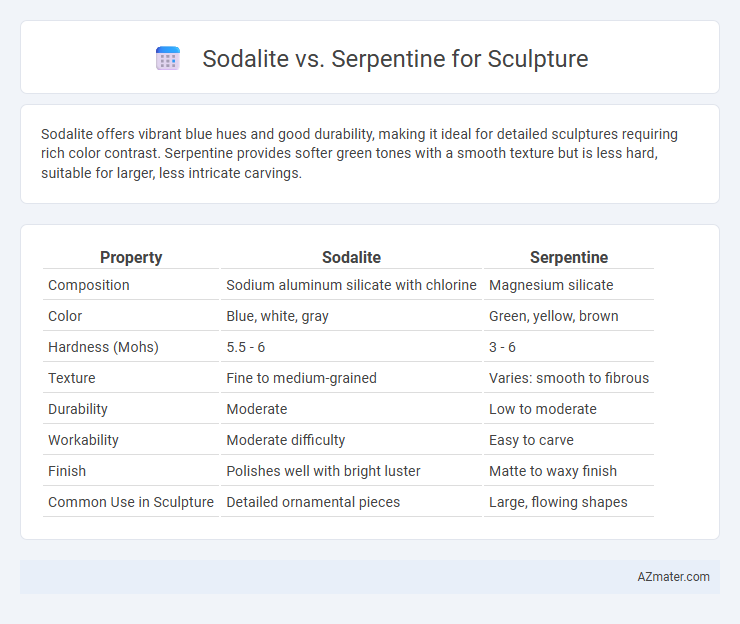Sodalite offers vibrant blue hues and good durability, making it ideal for detailed sculptures requiring rich color contrast. Serpentine provides softer green tones with a smooth texture but is less hard, suitable for larger, less intricate carvings.
Table of Comparison
| Property | Sodalite | Serpentine |
|---|---|---|
| Composition | Sodium aluminum silicate with chlorine | Magnesium silicate |
| Color | Blue, white, gray | Green, yellow, brown |
| Hardness (Mohs) | 5.5 - 6 | 3 - 6 |
| Texture | Fine to medium-grained | Varies: smooth to fibrous |
| Durability | Moderate | Low to moderate |
| Workability | Moderate difficulty | Easy to carve |
| Finish | Polishes well with bright luster | Matte to waxy finish |
| Common Use in Sculpture | Detailed ornamental pieces | Large, flowing shapes |
Understanding Sodalite and Serpentine: An Overview
Sodalite is a rich blue mineral known for its striking cobalt hues, commonly used in sculptures for its vibrant color and relatively easy carving properties. Serpentine, ranging from green to yellowish tones, offers a softer texture ideal for detailed work but tends to be less durable than sodalite in outdoor settings. Both minerals provide unique aesthetic qualities, with sodalite favored for bold, eye-catching sculptures and serpentine prized for smooth, intricate designs.
Geological Origins and Composition
Sodalite is a deep blue tectosilicate mineral primarily composed of sodium, aluminum, and chlorine, forming in igneous rocks such as nepheline syenites and pegmatites, prized for its vibrant color and uniform texture in sculpture. Serpentine, a group of greenish to yellowish phyllosilicate minerals, originates from the metamorphic alteration of ultramafic rocks like peridotite, featuring varying compositions of magnesium silicate and a distinctive fibrous or smooth structure ideal for intricate carving. The geological origins and mineralogical distinctions of sodalite and serpentine directly influence their color, hardness, and workability, making sodalite favored for bold, detailed sculptures and serpentine preferred for smooth, organic forms.
Color and Appearance Comparison
Sodalite exhibits a rich royal blue color often accented with white calcite veining, creating striking contrast and visual depth ideal for bold sculpture designs. Serpentine typically ranges from olive to lime green with smooth, waxy textures and occasional mottling, offering a softer, earthier appearance suited for organic, flowing forms. The vibrant blue hues of sodalite provide a dramatic presence, while serpentine's subdued greens bring a natural, calming aesthetic to sculptural works.
Workability: Ease of Carving and Shaping
Sodalite offers moderate workability, with a fine-grained texture that allows for precise detailing but requires sharp tools due to its relative hardness of 5.5-6 on the Mohs scale. Serpentine is softer, rating 2.5-4 on the Mohs scale, making it easier to carve and shape, especially for intricate designs or beginners. Sculptors often prefer serpentine for its smooth consistency and ability to hold polished finishes, while sodalite's vibrant blue hues are favored for decorative pieces requiring durability.
Durability and Hardness Differences
Sodalite exhibits a Mohs hardness of 5.5 to 6, making it moderately hard and suitable for detailed sculpting with a smooth polish. Serpentine, with a Mohs hardness of 2.5 to 5, is softer and more susceptible to scratches and wear, requiring careful handling and maintenance for sculptures. Durability-wise, sodalite resists weathering and impacts better than serpentine, which can be more prone to erosion and damage over time.
Cost and Availability for Sculptors
Sodalite is generally more expensive and less readily available than serpentine, making it a premium choice for sculptors seeking vibrant blue hues and unique patterns. Serpentine, abundant and cost-effective, is widely accessible, especially for large-scale or entry-level sculptures due to its softer texture and ease of carving. The cost differential and availability significantly influence material selection based on project budget and desired aesthetic.
Suitability for Indoor vs Outdoor Sculptures
Sodalite, known for its rich blue color and relative hardness, is suitable primarily for indoor sculptures due to its moderate weather resistance and tendency to fade or crack under prolonged outdoor exposure. Serpentine, softer and more porous with greenish hues, can be used for outdoor sculptures but requires sealing and regular maintenance to prevent weathering and moss growth. Both stones offer unique aesthetic qualities, but sodalite's durability favors controlled indoor environments while serpentine's versatility suits sheltered outdoor settings with proper care.
Aesthetic Appeal and Artistic Expression
Sodalite's deep blue color with white veining creates striking, vibrant sculptures that captivate viewers through rich contrast and intensity. Serpentine offers softer, earthy green hues with smooth, tactile surfaces that evoke natural aesthetics and organic forms, enhancing the sculpture's connection to nature. Artists favor Sodalite for bold, dramatic expression while Serpentine is chosen for subtle, calming beauty and intricate textural variation.
Popular Uses in Modern Sculpture
Sodalite is favored in modern sculpture for its rich blue color and fine grain, allowing detailed carving and polished finishes ideal for decorative art pieces. Serpentine offers a smoother texture and varying green hues, making it popular for larger, abstract sculptures and intricate inlays. Both stones provide durability and aesthetic appeal but cater to different artistic styles and color preferences in contemporary sculptural art.
Choosing the Right Stone: Sodalite or Serpentine?
Sodalite offers vibrant blue hues with white veining, making it ideal for striking, decorative sculptures that emphasize color contrast and intricate details. Serpentine provides a softer, green to yellow palette with a waxy texture, favored for its smooth carving properties and spiritual symbolism in art. Selecting between sodalite and serpentine depends on the desired aesthetic, durability, and carving complexity for the sculpture.

Infographic: Sodalite vs Serpentine for Sculpture
 azmater.com
azmater.com